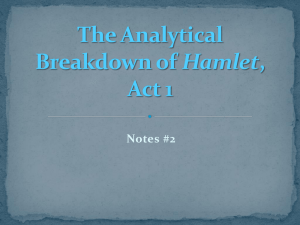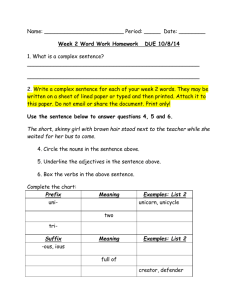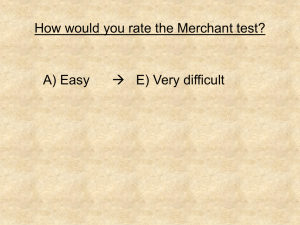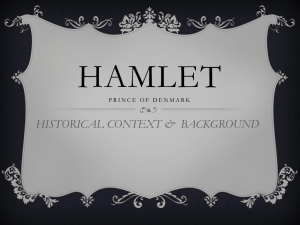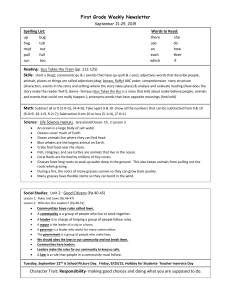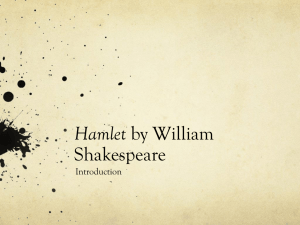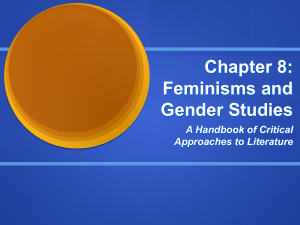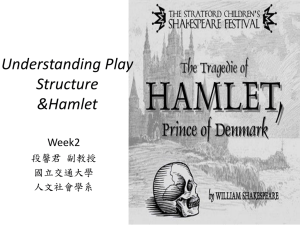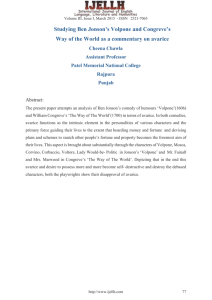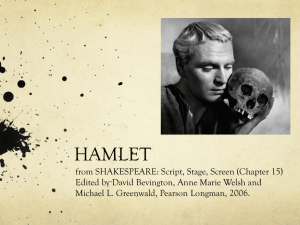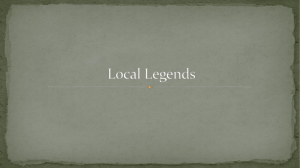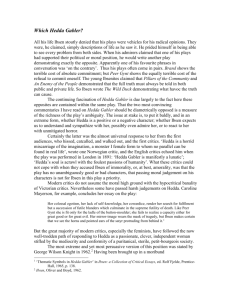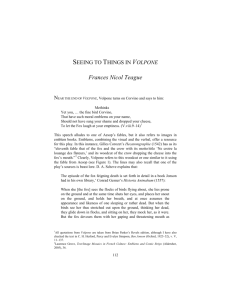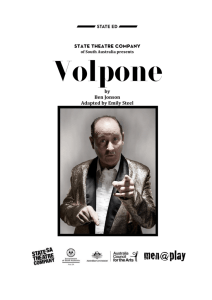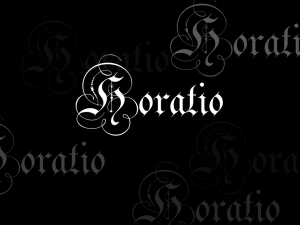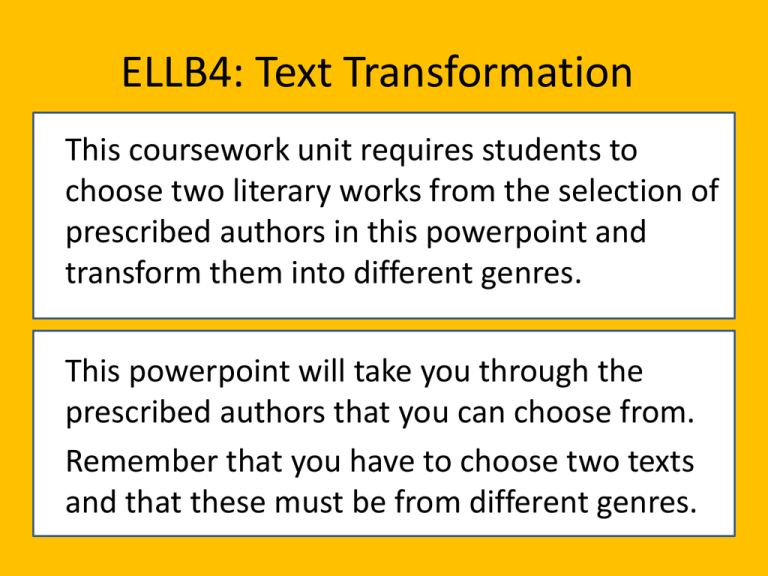
ELLB4: Text Transformation
This coursework unit requires students to
choose two literary works from the selection of
prescribed authors in this powerpoint and
transform them into different genres.
This powerpoint will take you through the
prescribed authors that you can choose from.
Remember that you have to choose two texts
and that these must be from different genres.
DRAMA
WILLIAM SHAKESPEARE (16th-17th century)
After studying two Shakespeare plays already, you are all aware of the style of
Shakespeare and some of his plays. Here are three Shakespeare plays that you
could potentially choose for your transformation:
HAMLET
Hamlet is a tragedy set in the
Kingdom of Denmark. The play
dramatizes the revenge Prince
Hamlet is instructed to enact on
his uncle Claudius. Claudius had
murdered his own brother,
Hamlet's father King Hamlet and
then taken the throne, marrying
his deceased brother's widow,
Hamlet's mother Gertrude.
Key Themes: The mystery of
death, religion, the nation as a
diseased body, incest and
misogyny.
KING LEAR
The titular character descends
into madness after disposing of
his estate between two of his
three daughters based on their
flattery, bringing tragic
consequences for all. The play is
based on the legend of Leir of
Britain, a mythological preRoman Celtic king. It has been
widely adapted for the stage and
motion pictures, and the role of
Lear has been coveted and
played by many of the world's
most accomplished actors.
Key Themes: Justice, Authority
versus Chaos, Madness and
Betrayal.
The Tempest
It is set on a remote island, where
Prospero, the rightful Duke of Milan,
plots to restore his daughter Miranda
to her rightful place using illusion and
skilful manipulation. He conjures up a
storm, the eponymous tempest, to
lure his usurping brother Antonio and
the complicit King Alonso of Naples to
the island. There, his machinations
bring about the revelation of
Antonio's lowly nature, the
redemption of the King, and the
marriage of Miranda to Alonso's son,
Ferdinand.
Key Themes: Racism, Colonialism,
Masters and Servants, Water and
Drowning
Ben Jonson
(14th-15th
Key Works
Century)
Volpone
The Alchemist
A Tale of a Tub
Epocine
Style:
• Artistic form
and control
• Highly polished
use of language
• Use of realism
• Seen as
‘strongly
masculinelacking
sentiment’
VOLPONE: This play contains Jonson's harshest and most unremitting
criticism of human vice. All the principal figures are named (in Italian)
after animals suggestive of their characters: for example, Volpone, the
cunning fox, and Voltore, the ravenous vulture. The main action turns
on Volpone's clever scheme to cheat those who are as greedy as he
but not nearly so clever. With the help of his servant Mosca, he
pretends to be deathly ill; each of the dupes, encouraged to believe
that he may be designated heir to Volpone's fortune, tries to win his
favor by presenting him with gifts. Volpone is too clever for his own
good, however, and is finally betrayed by Mosca and exposed to the
magistrates of Venice. The punishment imposed on him (and on the
self-seeking dupes as well) is unusually severe for a comedy; in fact,
there is almost nothing in Volpone which provokes laughter.
EPOCINE: The satire of Jonson's next three comedies is more indulgent.
Epicoene, or the Silent Woman (1609) is an elaborate intrigue built around
a farcical character with an insane hatred of noise. The principal intriguer,
Sir Dauphine Eugenie, tricks his noise-hating uncle Morose into marrying a
woman Morose believes to be docile and quiet. She, however, turns out to
be an extremely talkative person with a horde of equally talkative friends.
After tormenting his uncle and in effect forcing him into a public
declaration of his folly, Sir Dauphine reveals that Morose's voluble wife is
actually a boy disguised as a woman.
Aphra Behn
Key Works (17th
Century)
The Roundheads (1681)
The City Heiress(1682))
The Dutch Lover (1673)
Abdelazer (1676)
The Rover (1677)
Based on Thomas Killigrew's play Thomaso, or The Wanderer (1664),
The Rover features multiple plot lines, dealing with the amorous
adventures of a group of Englishmen in Naples at Carnival time.
The "rover" of the play's title is Willmore, a rakish naval captain, who
falls in love with a young woman named Hellena, who has set out to
experience love before her brother sends her to a convent.
Complications arise when Angellica Bianca, a famous courtesan, falls in
love with Willmore and swears revenge on him for his betrayal.
Meanwhile, Hellena's sister Florinda attempts to marry her true love,
Colonel Belvile, rather than the man her brother has selected. The
third major plot of the play deals with the provincial Blunt, who
becomes convinced that a girl has fallen in love with him but is
humiliated when she turns out to be a prostitute and a thief.
Extract from Prologue from The Rover (Part 2)
In vain we labour to reform the Stage,
Poets have caught too the Disease o' th' Age,
That Pest, of not being quiet when they're well,
That restless Fever, in the Brethren, Zeal;
In publick Spirits call'd, Good o'th' Commonweal.
Some for this Faction cry, others for that,
The pious Mobile for they know not what:
So tho by different ways the Fever seize,
In all 'tis one and the same mad Disease.
Our Author tool as all new Zealots do,
Full of Conceit and Contradiction too,
'Cause the first Project took, is now so vain…
Henrik Ibsen
Key Works (18th-20th
Century)
A Doll’s House
Hedda Gabbler
Ghosts
Style:
• Concerned with
society’s moral values
• Introspective
• Concerned with
psychological conflict
• Realist
HEDDA GABLER: Hedda is an intelligent and ambitious woman,
trapped in the stifling environment of a bourgeois 19th-century
marriage. When writer Eilert Loevborg, an old flame returns to
Hedda's life with a masterpiece that might threaten her husband's
career, Hedda decides to take drastic and fatal action. Universally
condemned in 1890 when it was written, Hedda Gabler has since
become one of Ibsen's most frequently performed plays. Its title role is
elusive and complex: Hedda is an intelligent and ambitious woman,
who has no means of finding personal fulfilment in the stifling world of
late nineteenth-century bourgeois society. Too frightened of scandal to
become involved with a brilliant, wayward writer, she opts for a
conventional but loveless marriage in the hope of finding surrogate
satisfaction through her husband's career. Blending comedy and
tragedy disconcertingly together, Ibsen probes the thwarted
aspirations and hidden anxieties of his characters against a background
of contemporary social conditions and attitudes.
A DOLL’S HOUSE: The play is significant for its critical attitude toward 19th
century marriage norms. It aroused great controversy at the time, as it
concludes with the protagonist, Nora, leaving her husband and children
because she wants to discover herself. Ibsen was inspired by the belief that
"a woman cannot be herself in modern society," since it is "an exclusively
male society, with laws made by men and with prosecutors and judges who
assess feminine conduct from a masculine standpoint
Tennessee Williams
Key Works (18th-20th
Century)
Cat on a Hot Tin Roof
Streetcar Named Desire
The Glass Menagerie
Style:
• Imagery in stage
directions
• Use of figurative
language
• Visual and sound
effects
• Uses classic character
archetypes and
transforms them:
demure Southern belle,
the chivalrous
gentleman, or the
righteous Christian
preacher.
THE GLASS MENAGERIE: The characters and story mimic Williams's
own life more closely than any of his other works. Williams (whose
real name was Thomas) would be Tom, his mother, Amanda. His sickly
and mentally unstable older sister Rose provides the basis for the
fragile Laura (whose nickname in the play is "Blue Roses", a result of a
bout of pleurosis as a high school student), though it has also been
suggested that Laura may incorporate aspects of Williams himself,
referencing his introverted nature and obsessive focus on a part of life
(writing for Williams and glass animals in Laura's case). The play is
introduced to the audience by Tom, the narrator and protagonist, as a
memory play based on his recollection of his mother Amanda and his
sister Laura.
A Streetcar Named Desire is the tale of a catastrophic confrontation
between fantasy and reality, embodied in the characters of Blanche DuBois
and Stanley Kowalski. Fading southern belle Blanche DuBois is adrift in the
modern world. When she arrives to stay with her sister Stella in a crowded,
boisterous corner of New Orleans, her delusions of grandeur bring her into
conflict with Stella's crude, brutish husband Stanley Kowalski. Eventually
their violent collision course causes Blanche's fragile sense of identity to
crumble, threatening to destroy her sanity and her one chance of
happiness.
Alan Bennett
Key Works (20th-21st)
The Madness of George III
1991
Talking Heads 1992
The History Boys 2004
People 2012
Style:
• Conversational
• Use of dramatic
monologues
• Realistic
• Idiomatic
expressions
• Use of dialect to
influence his
language
• Humour and irony
TALKING HEADS: Talking Heads is a series of dramatic monologues
written for BBC television by British playwright Alan Bennett. There
are two series of Talking Heads, six monologues in each, along with an
earlier (1982) play, A Woman of No Importance, which, while not
released alongside Talking Heads, generally fits into the canon.
Although the plays deal with a variety of subjects, there are certain
recurring themes, such as death, illness, guilt and isolation.
Most of the plays give some hint as to where they are set, mostly in
Leeds, although not (as Bennett stresses) the "real" Leeds, but rather
one that exists in his head.For example, Matthias Robinsons, in which
Miss Fozzard works, closed in the 1970s.
THE HISTORY BOYS: The play opens in Cutlers' Grammar School, Sheffield,
a fictional boys' grammar school in the north of England. Set in the early
1980s, the play follows a group of history pupils preparing for the Oxford
and Cambridge entrance examinations under the guidance of three
teachers (Hector, Irwin and Lintott) with contrasting styles.
Hector, an eccentric teacher, delights in knowledge for its own sake, but
the headmaster ambitiously wants the school to move up the academic
league table; Irwin, a supply teacher, is hired to introduce a rather more
cynical and ruthless style of teaching. Hector is discovered sexually fondling
a boy and later Irwin's latent homosexual inclinations emerge.
The character of Hector was based on the schoolmaster and author Frank
McEachran (1900–1975).
Caryl Churchill
Key Works (20th-21st)
Serious Money
Seven Jewish Children: A
Play for Gaza
Style:
• Non-naturalistic
techniques
• Loyalty to feminist
themes and ideas
• Concerned with the
abuse of power
• Exploration of sexual
politics
• Can be satirical
SERIOUS MONEY: The plot follows Scilla and Jake who are enjoying the pleasures
and the comforts of the upper class. But the story climaxes when Jake Todd
turns up murdered during the first few scenes due to his underground trading.
Scilla takes it upon herself to find her brother's killer and the money he was
dealing. She later finds out that he was being investigated by the Department of
Trade and Industry. Though she does not find the killer, she finds the American
business woman Marylou Banes with whom Jake was dealing. Marylou Banes
offers her a fresh start. The story takes place around the stock market troubles in
Britain.
Aside from that a second story follows Billy Corman's and Zac Zackerman's
attempt to take over the Albion company from Duckett. In between this
takeover Corman attempts to get Jacinta Condor and Nigel Ajibala [who are the
foreigners with an interest in his takeover] to buy shares in his company. They
support Corman but decide to give their bid to Duckett in the end.
The plot ends with Greville Todd in jail, Corman appointed as a Lord, and Scilla
happily working for Marylou Banes.
Seven Jewish Children consists of seven scenes spread over roughly seventy
years, in which Jewish adults discuss what, or whether, their children
should be told about certain events in recent Jewish history that the play
alludes to only indirectly : The Holocaust, Jewish immigration to Palestine,
the creation of Israel, the flight or expulsion of Palestinian Arabs, the 194
Arab-Israeli War, the dispute over water, the First Intifada, the death of
Rachel Corrie, the building of the West Bank barrier, the death of
Muhammad al-Durrah, Palestinian suicide attacks, Hamas rocket attacks,
and the 2008 bombing of Gaza.
David Mamet
Key Works (20th-21st)
Glengarry Glen Ross
Speed-the-Plow
Sexual Perversity in
Chicago
Style:
• Mamet's style of
writing dialogue,
marked by a cynical,
street-smart edge,
precisely crafted for
effect, is so distinctive
that it has come to be
called ‘Mamet speak’
• Italics and quotation
marks to emphasize
language
• Interruption and
dialogue overlaps
Glengarry Glen Ross is a play by David Mamet that won the Pulitzer Prize in
1984. The play shows parts of two days in the lives of four desperate Chicago
real estate agents who are prepared to engage in any number of unethical,
illegal acts—from lies and flattery to bribery, threats, intimidation and
burglary—to sell undesirable real estate to unwitting prospective buyers. It is
based on Mamet's earlier workings in a similar office.
Sexual Perversity in Chicago is a play written by David Mamet that
examines the sex lives of two men and two women in the 1970s. The
play is filled with profanity and regional jargon that reflects the
working-class language of Chicago. The characters' relationships
become hindered by the caustic nature of their words, as much of
the dialogue includes insults and arguments. The play presents
"intimate relationships [as] minefields of buried fears and
misunderstandings".
Harold Pinter
Key Works (20th-21st)
The Caretaker
No Man’s Land
The Dumb Waiter
Voices
Style:
• Comedy of menace
• Mainly about
domination and
submission
• Colloquial language
• Use of long pauses
• Concerned with the
implications of threat
and strong feeling
THE DUMB WAITER: Two hit-men, Ben and Gus, are waiting in a basement room
for their assignment. As the play begins, Ben, the senior member of the team, is
reading a newspaper, and Gus, the junior member, is tying his shoes. Gus asks
Ben many questions as he gets ready for their job and tries to make tea. They
argue over the semantics of "light the kettle" and "put on the kettle". Ben
continues reading his paper for most of the time, occasionally reading excerpts
of it to Gus. Ben gets increasingly animated, and Gus's questions become more
pointed, at times nearly nonsensical.
In the back of the room is a dumb waiter, which delivers occasional food orders.
This is mysterious and both characters seem to be puzzled why these orders
keep coming. At one point they send up some snack food that Gus had brought
along. Ben has to explain to the people above via the dumbwaiter's "speaking
tube" that there is no food. This whole sequence is rather odd because the
basement is clearly not outfitted for fulfillment of the orders.
Gus leaves the room to get a drink of water in the bathroom, and the
dumbwaiter's speaking tube whistles (a sign that there is a person on the other
end who wishes to communicate). Ben listens carefully—we gather from his
replies that their victim has arrived and is on his way to the room. Ben shouts for
Gus, who is still out of the room. The door that the target is supposed to enter
from flies open, Ben rounds on it with his gun, and Gus enters, stripped of his
jacket, waistcoat, tie and gun. There is a long silence as the two stare at each
other before the curtain comes down (the implication is that Gus is the person
that Ben has been employed to kill).
Brian Friel
Key Works (20th-21st)
Translations
Dancing at Lughnasa
Philadephia, Here I come!
Style:
• Can be political
• Interested in
language divide
• Concerned with ‘Irish
male experience’
Dancing at Lughnasa is a 1990 play by dramatist Brian Friel set in Ireland's
County Donegal in August 1936 in the fictional town of Ballybeg. It is a Memory
play told from the point of view of the adult Michael Evans, the narrator. He
recounts the summer in his aunts' cottage when he was seven years old. This
play is loosely based on the lives of Friel's mother and aunts who lived in
Glenties, on the west coast of Donegal. Set in the summer of 1936, the play
depicts the late summer days when love briefly seems possible for three of the
Mundy sisters (Chris, Rose, and Kate) and the family welcomes home the frail
elder brother, who has returned from a life as a missionary in Africa. However, as
the summer ends, the family foresees the sadness and economic privations
under which they will suffer as all hopes fade.
The play takes place in early August, around the festival of Lughnasadh, the
Celtic harvest festival. The play describes a bitter harvest for the Mundy sisters,
a time of reaping what has been sown.
Translations is a three-act play by Irish playwright Brian Friel, written in 1980. It is
set in Baile Beag (Ballybeg), a Donegal village in 19th century agricultural Ireland.
Friel has said that Translations is "a play about language and only about language",
but it deals with a wide range of issues, stretching from language and
communication to Irish history and cultural imperialism. Friel responds strongly to
both political and language questions in modern-day Northern Ireland. He said that
his play "should have been written in Irish" but, despite this fact, he crafted carefully
the verbal action in English which makes the dynamics of the play come alive, and
brings its political questions into true focus.
Baile Beag ("Small Town") is a fictional village, created by Friel as a setting for
several of his plays, although there are many real places called Ballybeg throughout
Ireland.
Alan Ayckbourn
Key Works (20th-21st)
A Small Family Business
Bedroom Farce
Intimate Exchanges
Style:
• Has written
unconventional plays
(such as ones with
multiple endings)
• In his early career,
Ayckbourn had a
recurring theme of
marriage.
• Uses staging techniques
to transcend space and
time.
A Small Family Business: Jack McCracken: a man of principle in a corrupt world. But
not for long. Moments after taking over his father-in-law's business he's approached
by a private detective armed with some compromising information.
Jack's integrity fades away as he discovers his extended family to be thieves and
adulterers, looting the business from their suburban homes. Rampant self-interest
takes over and comic hysteria builds to a macabre climax. The play is a riotous
exposure of entrepreneurial greed.
Bedroom Farce is a comedy that contains a melee of events involving certain
philandering characters, all occurring within similar moments of one another.
Alan Ayckbourn’s clever uses of time and space makes this a very intricate and
sophisticated comedy while also portraying the deteriorating and rebuilding of
relationships among young couples. This play explores the differences in
relationships between the younger and older generations while capitalizing on
certain unlikely issues that may strain the relationships even further. Although
Ayckbourn uses hints of homosexuality in this play, this doesn't seem to have a
huge part in his play as a whole, but can be interpreted to have a stronger
deeper meaning within the play. As the title implies, the play is an absurd and
confusing farce, comparing and contrasting the differences between couples
young and old, and the different troubles they encounter. This play had certain
sadistic aspects involving cheating, and lying, which evolves into forgiveness and
devotion. Although the play may seem to lead into a corner of despair and
heartbreak, it substitutes the hard truths of certain relationships into
relationships that may have a chance at survival.
Tom Stoppard
Key Works (20th-21st)
• Rosencrantz and
Guildenstern Are Dead
• Arcadia
Style:
• Work is usually socially
engaged especially with
regard to politics
• Wit and comedy
• Usually about
philosophical concepts
• Use of juxtaposition
• Later plays concern the
themes of Repression
and State Censorship
Rosencrantz and Guildenstern Are Dead is an absurdist, existentialist tragicomedy
first staged at the Edinburgh Festival Fringe in 1966. The play expands upon the
exploits of two minor characters from Shakespeare's Hamlet, the courtiers
Rosencrantz and Guildenstern. The action of Stoppard's play takes place mainly "in
the wings" of Shakespeare's, with brief appearances of major characters from
Hamlet who enact fragments of the original's scenes. Between these episodes the
two protagonists voice their confusion at the progress of events of which—occurring
onstage without them in Hamlet—they have no direct knowledge.
Arcadia is set in Sidley Park, an English country house, and takes place in both 1809–
1812 and the present day (1993 in the original production). The activities of two
modern scholars and the house's current residents are juxtaposed with the lives of
those who lived there 180 years earlier.
In 1809, Thomasina Coverly, the daughter of the house, is a precocious teenager with
ideas about mathematics well ahead of her time. She studies with her tutor Septimus
Hodge, a friend of Lord Byron (who is himself an unseen guest in the house). In the
present, a writer and an academic converge on the house: Hannah Jarvis, the writer, is
investigating a hermit who once lived on the grounds; Bernard Nightingale, a professor
of literature, is investigating a mysterious chapter in the life of Byron. As their
investigations unfold with the help of Valentine Coverly, a post-graduate student in
mathematical biology, the truth about what happened in Thomasina's lifetime is
gradually revealed.
The play's set features a large table, which is used by the characters in both past and
present. Props are not removed when the play switches time period, so that books,
coffee mugs, quill pens, portfolios, and laptop computers appear alongside each other
in a blurring of past and present. An ancient but still living tortoise also appears in
every scene, symbolising long-suffering endurance and continuity of existence.

